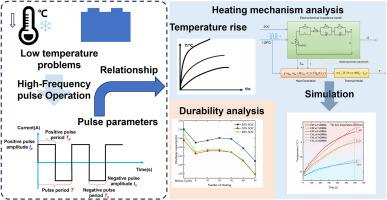Application of high frequency square wave pulsed current on lithium-ion batteries at subzero temperature
IF 7.9
2区 工程技术
Q1 CHEMISTRY, PHYSICAL
引用次数: 0
Abstract
The performance degradation of lithium-ion batteries in low-temperature environments significantly impedes their application in power battery and electrochemical energy storage sectors. This study investigates the application of HF (high-frequency) square-wave pulsed current to mitigate capacity degradation and charging/discharging challenges in lithium-ion batteries at subzero temperatures. Initially, an electrochemical impedance-thermal coupling model, applicable to the preheating of pulsed currents across the full frequency spectrum, is formulated. Subsequently, the model parameters are ascertained through the design of thermo-physical experiments and an enhanced particle swarm optimization algorithm. The investigation proceeds to examine the impact of HF pulsed current parameters on the preheating and aging of cells with varying initial SOC (State of Charge). Experimental outcomes reveal that the temperature estimation error is confined to within 1.5 °C for pulsed amplitudes of 5A, 7A, and 9A, at a pulsed frequency of 2.5 kHz and an ambient temperature of −17 °C. Comparative assessments of the influence of HF pulsed current parameters on low-temperature warm-up rates and battery longevity demonstrate minimal capacity loss across batteries with differing SOCs. Specifically, at a pulsed current of 3.6C, the capacity retention rate surpasses 96 % after 50 heating cycles. The optimization of pulsed current parameter design, in conjunction with pulsed charging applications, presents practical significance and furthers the exploration of low-temperature applications for HF pulsed operation in lithium-ion batteries.

高频方波脉冲电流在低温锂离子电池上的应用
锂离子电池在低温环境下的性能下降严重阻碍了其在动力电池和电化学储能领域的应用。本研究探讨了HF(高频)方波脉冲电流的应用,以减轻锂离子电池在零下温度下的容量退化和充放电挑战。首先,建立了一个适用于全频谱脉冲电流预热的电化学阻抗-热耦合模型。随后,通过热物理实验设计和改进的粒子群优化算法确定模型参数。研究了不同初始荷电状态下高频脉冲电流参数对电池预热和老化的影响。实验结果表明,当脉冲频率为2.5 kHz,环境温度为- 17℃时,脉冲振幅为5A、7A和9A时,温度估计误差限制在1.5℃以内。对高频脉冲电流参数对低温预热率和电池寿命影响的对比评估表明,不同soc电池的容量损失最小。具体而言,在3.6C的脉冲电流下,经过50次加热循环后,容量保持率超过96%。优化脉冲电流参数设计,结合脉冲充电应用,具有现实意义,进一步探索HF脉冲工作在锂离子电池中的低温应用。
本文章由计算机程序翻译,如有差异,请以英文原文为准。
求助全文
约1分钟内获得全文
求助全文
来源期刊

Journal of Power Sources
工程技术-电化学
CiteScore
16.40
自引率
6.50%
发文量
1249
审稿时长
36 days
期刊介绍:
The Journal of Power Sources is a publication catering to researchers and technologists interested in various aspects of the science, technology, and applications of electrochemical power sources. It covers original research and reviews on primary and secondary batteries, fuel cells, supercapacitors, and photo-electrochemical cells.
Topics considered include the research, development and applications of nanomaterials and novel componentry for these devices. Examples of applications of these electrochemical power sources include:
• Portable electronics
• Electric and Hybrid Electric Vehicles
• Uninterruptible Power Supply (UPS) systems
• Storage of renewable energy
• Satellites and deep space probes
• Boats and ships, drones and aircrafts
• Wearable energy storage systems
 求助内容:
求助内容: 应助结果提醒方式:
应助结果提醒方式:


